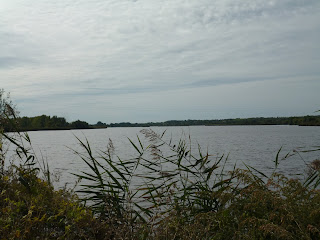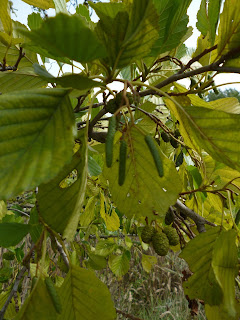Luckily we had a very fine day with sunshine and little wind so if I would have a proper binocular and telescope I could have indentified plenty more species.
So far I identified the followings:
- Ardea cinerea - Grey Heron (I've seen a lot foraging near a fish school where they weren't doing much harm to the stock I guess. It was a mixed group of herons and egrets.)
- Egretta alba - Great Egret
- Platalea leucordia - Eurasian Spoonbill (We saw them flying over to the South. They also fly in "V" formation like geese.)
- Anser anser - Greyleg Goose (There were plenty on the water, and I'm not sure they were summer residents as they were quite alert when we approached, even though they were hidden from us behind the reed beds.)
- Anas platyrchynchos - Mallard
- Fulica atra - Eurasian Coot (I did not count them but there were more then hundrends I reckon.)
- Vanellus vanellus - Northern Lapwing
- Larus canus - Mew Gull
- Larus michachellis - Yellow-legged Gull (They are tricky and I can not say for sure the species withough a proper equipment.)
- Pica pica - Eurasian Magpie
- Corvus cornix - Hooded Crow
- Passer montanus - Eurasian Tree Sparrow
- Remiz pendulinus - Eurasian Penduline Tit
- Parus major - Great tit
- Struthio camelus - Common ostrich (flying over - hahaha)
I will work out a way to make the bird list more sensible. I have a little note book to write down whatever I see on the field. I do not note the species in systematic order rather than I try to follow the bird guide to make the above list.
This is the train station of Rétszilas. I love this kind of stations. There aren't many tourist coming by train so there isn't any facility to make ourself comfortable though. The building itself functions as an appartement as well but no cash desk, toilet and very little waiting room with an old timetable for the trains. The people there were friendly and kindly showed us the way to the nature reserve. There is a village called Rétszilas but it is not behind the train station. It is circa 5km away from there. (In Hungarian: http://www.vasutallomasok.hu/allomas.php?az=rtsz or http://hu.wikipedia.org/wiki/Pusztaszabolcs%E2%80%93Duna%C3%BAjv%C3%A1ros%E2%80%93Paks-vas%C3%BAtvonal)
Roship, full of vitamin C but not ripe enough yet.
The area is framed by two channels and the lakes are fed by them. I follow this book during the "ramsar-tour" project. It is possible also to check details of the different Ramsar sites here: http://www.ramsar.hu/teruletek/20.htm
This Ramsar site was not only about nature but culture as well. One could have a nice luch at the local restaurant and the staff was actually very nice and welcoming!
My camera isn't appropriate I'm afraid to take pictures of birds but for this blog I do my best to take some photos of different plants and the area itself. When I'm able to catch a moment of birdlife I will certainly publish it here as well.
The only fishery museum in Hungary. A bit dusty but very interesting. There are explanations of the equipment in English and German too.



















